1. Introduction
Managing content in different languages is a very complex issue and is often done in cooperation with a special translation office. However, since you do not necessarily want those to work with your system, a module is needed which allows to manage the process of submitting data to be translated out of FirstSpirit into a target system or reimporting finished translations into FirstSpirit again.
2. translationstudio
translationstudio enables you to manage this process and customise it to meet your particular needs, either in terms of IT-infrastructure or editing and translation processes. The application is based on 3 principles:
-
Ease of Use
-
Easy Installation and Configuration
-
Integration into existing processes and workflows
2.1. Ease of use
By using the translationstudio module, editors can conveniently and directly highlight the content selected for translation in FirstSpirit SiteArchitect or ContentCreator and forward it to translationstudio for translation. The module manages everything else. All the editor has to do is starting a workflow.
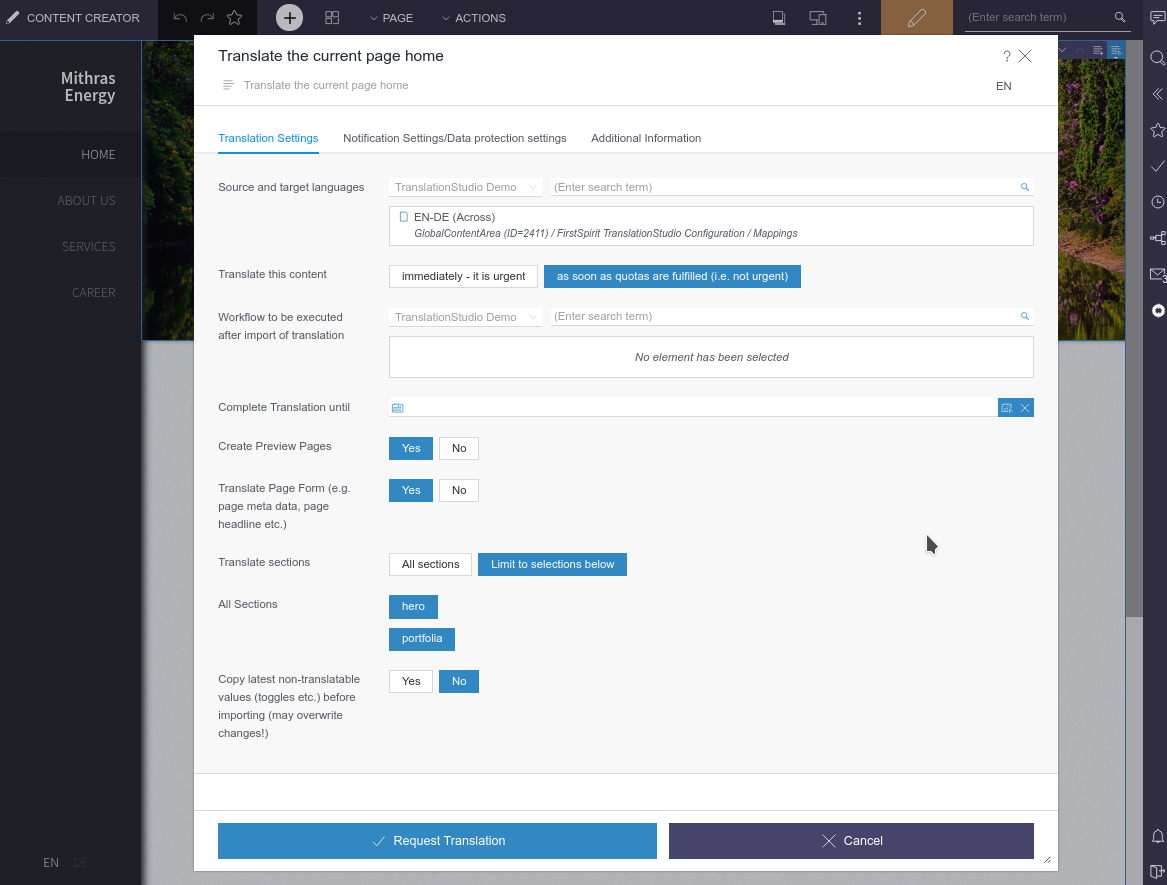
The translationstudio allows to forward individual sections, entire pages or complete projects for translation, thus providing optimal support for companies in rolling out additional country or language specific projects.
As soon as the translation has been completed, either the system takes over and imports the content directly or you download it from the translation system and drop it in a special translationstudio folder at a later stage.
The process is transparent at any stage. translationstudio informs a user about any state changes via email and an optional status indicator icon containing the most recent status information regarding the respective page.
If more detailed information a required, a report component extending the SiteArchitect or ContentCreator allows for a more advanced feedback option.
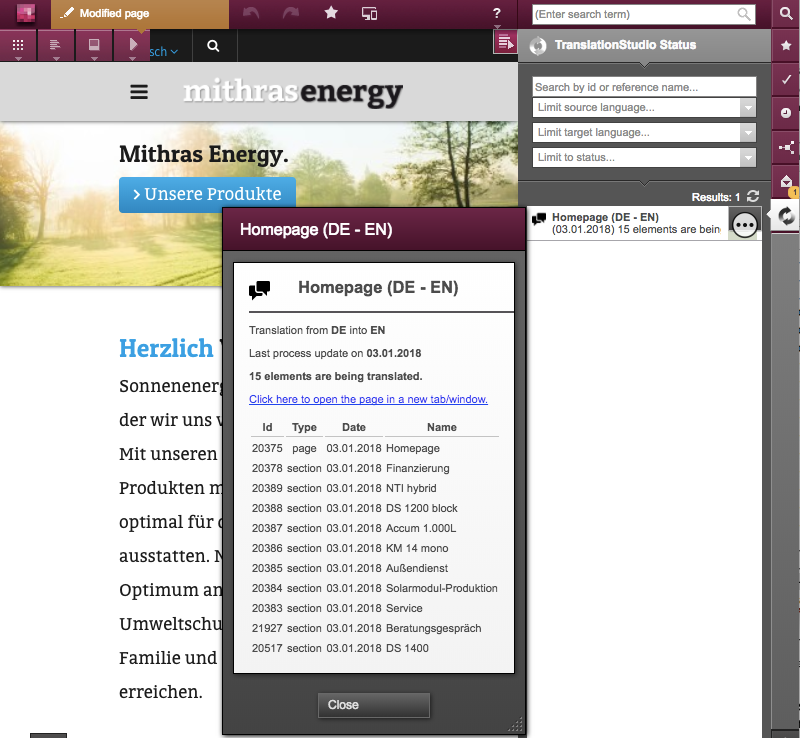
2.2. Easy installation and configuration
FirstSpirit is the single point of configuration. translationstudio provides you with installation scripts which do most of the work for you. A step-by-step installation instruction further reduces the complexity.
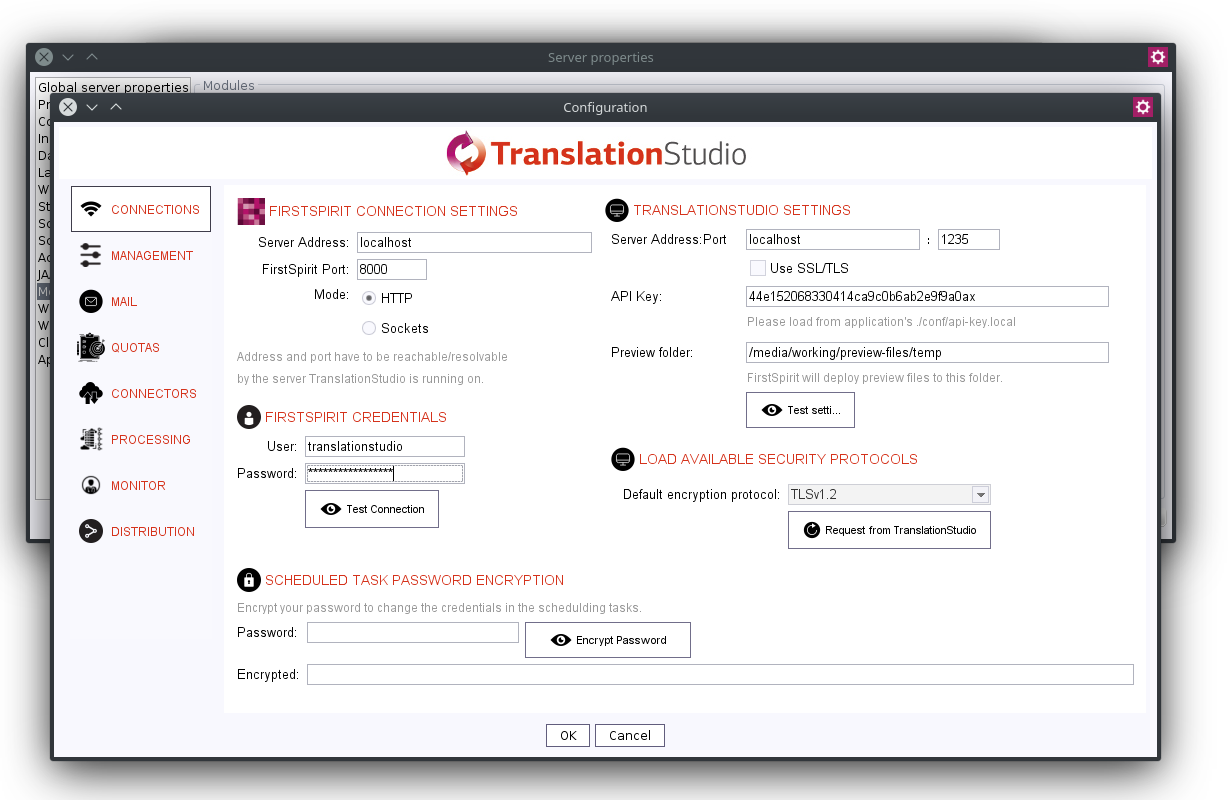
2.3. Integration into existing processes and workflows
translationstudio is designed to be as flexible as possible to enable you to use the module in a way that best fits your needs.
-
FirstSpirit Workflows allow you to combine a translation request with particular custom workflow (including permission management).
-
FirstSpirit permissions give you full control over who is able to use the product.
-
Relying primarily on FirstSpirit components, translationstudio allows for efficient integration and update compatibility.
-
FirstSpirit scheduled tasks allow you to decide when translation requests are being forwarding to translationstudio’s core management component.
-
By separating the FirstSpirit CMS module from translationstudio’s core management component, you have full control over the IT infrastructure and are able to reduce CMS Server workload.
-
You do not need to use a translation memory system. By default, a translatable XML is stored in a specific directory on the file system. To re-import your processed XML into FirstSpirit, you only need to copy the translated document into a specific target directory.
-
You may also implement your own translation memory system connector by using the translationstudio’s connector API.
-
translationstudio provides various access points at which you can influence the process of operation and, for example, convert the translatable xml into another format if your target TMS requires such a format.
3. Benefits of working with translationstudio
3.1. Timing Control and Cost Optimisation
translationstudio allows companies to report on their translations and perform them in a cost-effective manner. The module collects translation requests and only forwards them when a certain, (fully configurable) threshold has been reached to ensure an optimal workload for the translator. Alternatively, urgent translation may bypass this process at any stage.
3.2. Language variant support
Sometimes, certain languages require a specific order of translation, for example from German via English to Chinese. Both parts of this process not only require a (different) professional translator, but also technical assistance. translationstudio helps you here. Configure source and target languages for translation with a simple mouse click.
3.3. Use the translation memory system of your choice
translationstudio is designed and developed to communicate with different translation memory systems using special connector which are optionally available.
Irrespective of whether you are using one of the larger enterprise systems, such as Trados or Across, or whether you prefer cloud-based solutions, like market leaders lingoking or translations.com, translationstudio is supplied with a connector most relevant to you if required.
4. Architecture
translationstudio consists of two components
-
translationstudio Module (FSM) running in FirstSpirit
-
translationstudio Application being the core management component.
While the FirstSpirit Module (FSM) has to be installed and configured using the FirstSpirit ServerManager, the translationstudio Application can be installed on any server, as long as a sharing of certain resources is possible as described below.
Both modules communicate with each other using a specific port. Yet, the communication is initiated solely by FirstSpirit and uses HTTP requests to access the REST-API of the translationstudio Application.
4.1. FirstSpirit FSM Module
The FirstSpirit FSM Module provides all means necessary to use the translationstudio in FirstSpirit and to communicate with the translationstudio Application.
However, all parts of FirstSpirit FSM Module work within FirstSpirit and do not process tasks other than requesting a translation of elements and information management for the user.
4.2. translationstudio Application
The translationstudio Application is the core programme which keeps track of translations, receives information of new pages to be translated and initiates translations and imports translated data into FirstSpirit.
In addition, this programme is also responsible for the entire data management related to a translation, e.g. fetching the respective pages from FirstSpirit.
Security aspects
Please make sure that the port both programmes use for communication is accessible and not blocked by a firewall. In addition, if the translationstudio Application runs on a different server, both servers have to be able to communicate with each other.
Finally and importantly, please make sure that the port used by the translationstudio Application is not publicly accessibly but only within your network, and preferably limited to those servers requiring it, according to your security policies.
4.3. Scenarios
Basically, two scenarios of integrating and operating FirstSpirit translationstudio are possible and will be described briefly in the following.
Importantly, there are no limitations for the user. They either use the SiteArchitect or ContentCreator to register pages for translation. This request will be forwarded to the FirstSpirit translationstudio Service running on the FirstSpirit Server.
This service will forward the request to the translationstudio Application where it will be processed.
-
Running FirstSpirit translationstudio on the CMS server.*
In this simple scenario, the FirstSpirit translationstudio runs on the FirstSpirit server. Consequently, they also share the system’s resources.
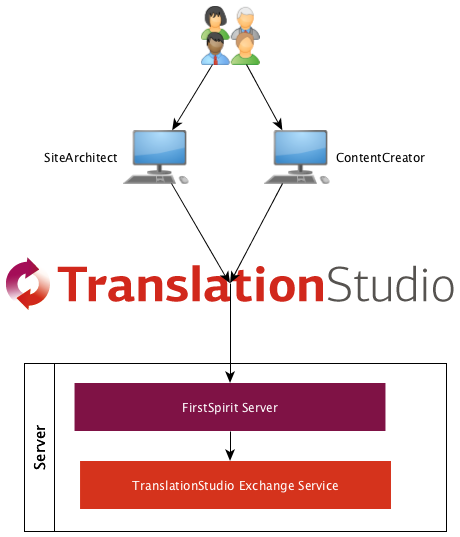
Running FirstSpirit translationstudio on different server.
In this advanced scenario, translationstudio Application runs on a different server. This solution reduces FirstSpirit server workload and might be appropriate high availability clusters or projects.
The server running the translationstudio Application is further secured by a firewall to limit net exposure.
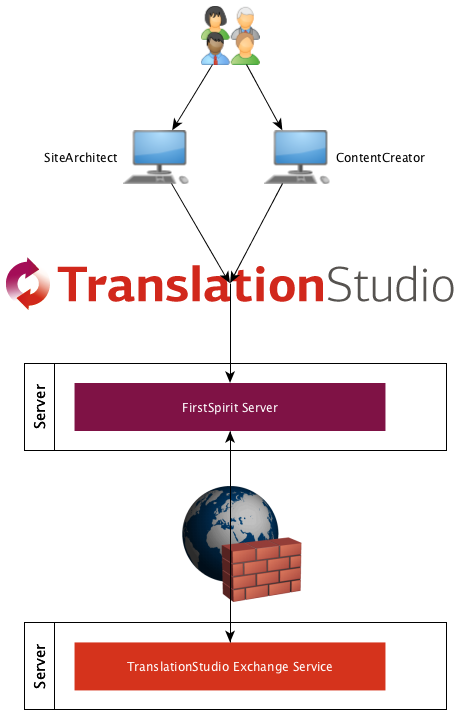
4.4. System requirements: Short overview
-
Operating systems (each in 64-bit variant only)
Microsoft Windows Server or Linux (Red Hat / SUSE / Debian or similar) -
Hardware
Approx. 2 GB of RAM
Approx. 1 GB free disk space -
FirstSpirit
Version 5.2.200410 -
Java
JDK 17
Java Persistence Api 2.1 -
Database (optional)
MySQL 5.6 or newer,
Microsoft SQL Server 2008 or newer,
PostgreSQL
The amount of RAM and disk space required varies according to your project and mode of operation.
5. Frequently asked questions
This section answers frequently and reoccurring questions about translationstudio.
Is it possible to translate datasets?
Yes, translationstudio can be used to translate datasets and pages/sections alike.
Does translationstudio support XLIFF - Which XML format does translationstudio use?
translationstudio uses its own XML format which embed the FirstSpirit XML to avoid too many transformations. However, it is possible to develop a translationstudio plugin to transform our XML into another, such as XLIFF.
Is a Translation Memory System required?
No, translationstudio does not require it. Translatable XML files will be stored in a specific directory from which you may get translatable documents.Translated XML documents can be deployed into another specific translationstudio directory to trigger the import into FirstSpirit.
Can I use multiple Translation Memory Systems at the same time?
Yes, this is possible without specific adjustments.
I have a complex translation process. How can translationstudio integrate into it? translationstudio allows you to execute plugins (Hooks) at certain access points, e.g. after having created translatable documents. Here, a plugin would allow you to add additional files (e.g. meta files) containing relevant management data.
In addition, the translationstudio workflow form can be extended to add more information to be sent along with your translatable files. A common scenario would be to add a cost centre or ask for an estimation of cost. This, obviously, depends on your specific process. However, translationstudio has means to add such necessities.
Can I see a demo?
Yes, we will gladly show you a demo of translationstudio. Simply contact your e-Spirit contact person or visit the e-Spirit marketplace.
Where can I find further information?
If you require further or more detailed information, please do not hesitate to contact your e-Spirit contact person or visit the e-Spirit marketplace. The e-Spirit community might also be a good starting point.